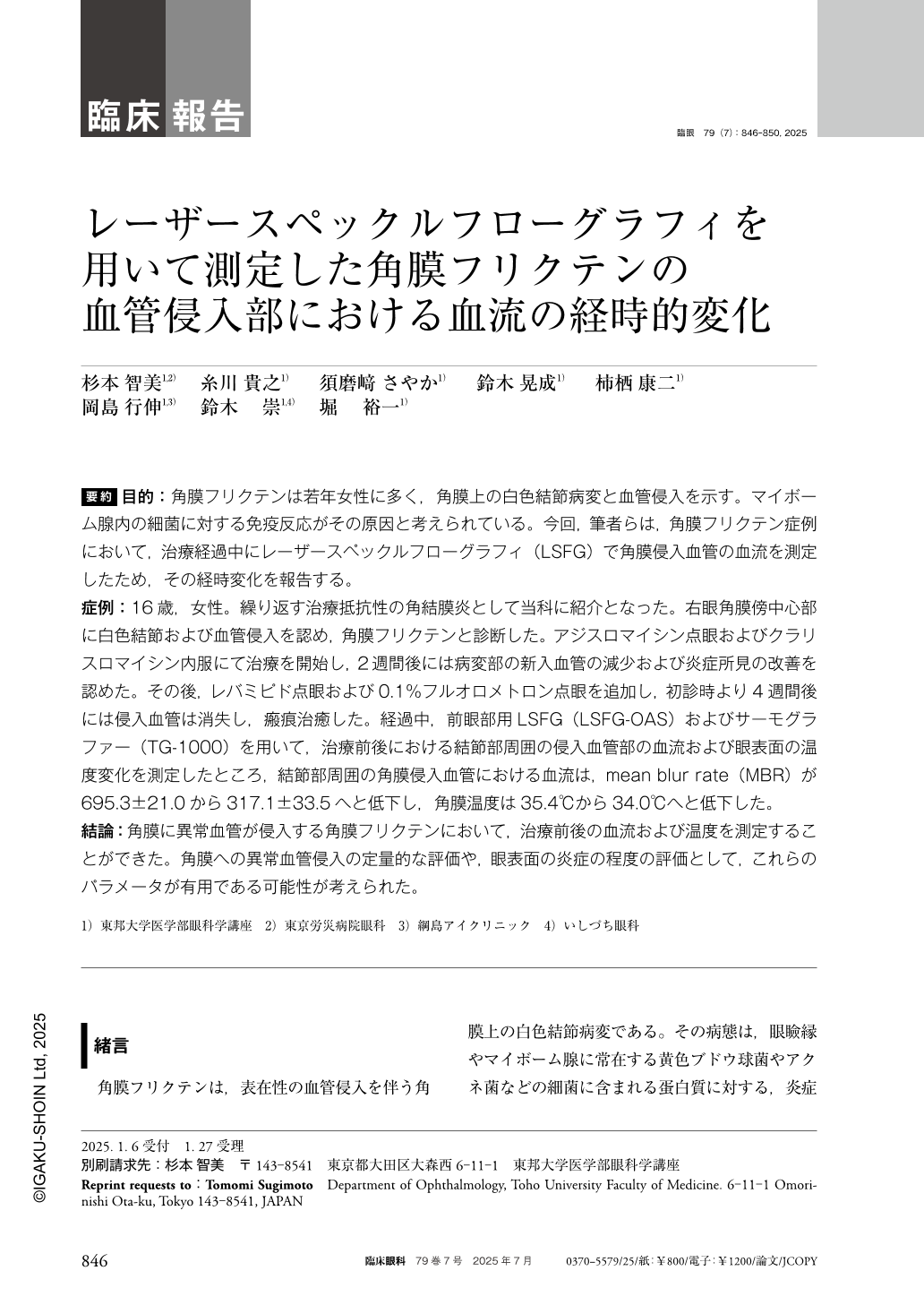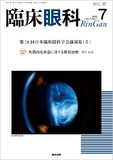Japanese
English
- 有料閲覧
- Abstract 文献概要
- 1ページ目 Look Inside
- 参考文献 Reference
要約 目的:角膜フリクテンは若年女性に多く,角膜上の白色結節病変と血管侵入を示す。マイボーム腺内の細菌に対する免疫反応がその原因と考えられている。今回,筆者らは,角膜フリクテン症例において,治療経過中にレーザースペックルフローグラフィ(LSFG)で角膜侵入血管の血流を測定したため,その経時変化を報告する。
症例:16歳,女性。繰り返す治療抵抗性の角結膜炎として当科に紹介となった。右眼角膜傍中心部に白色結節および血管侵入を認め,角膜フリクテンと診断した。アジスロマイシン点眼およびクラリスロマイシン内服にて治療を開始し,2週間後には病変部の新入血管の減少および炎症所見の改善を認めた。その後,レバミピド点眼および0.1%フルオロメトロン点眼を追加し,初診時より4週間後には侵入血管は消失し,瘢痕治癒した。経過中,前眼部用LSFG(LSFG-OAS)およびサーモグラファー(TG-1000)を用いて,治療前後における結節部周囲の侵入血管部の血流および眼表面の温度変化を測定したところ,結節部周囲の角膜侵入血管における血流は,mean blur rate(MBR)が695.3±21.0から317.1±33.5へと低下し,角膜温度は35.4℃から34.0℃へと低下した。
結論:角膜に異常血管が侵入する角膜フリクテンにおいて,治療前後の血流および温度を測定することができた。角膜への異常血管侵入の定量的な評価や,眼表面の炎症の程度の評価として,これらのパラメータが有用である可能性が考えられた。
Abstract Purpose:Phlyctenular keratitis predominantly affects young women and is characterized by white nodular lesions on the cornea accompanied by vascular invasion. The condition is believed to result from an immune response to bacterial proteins in the meibomian glands. Here, we report time-dependent changes in corneal vascular blood flow, measured using laser speckle flowgraphy(LSFG), during the course of treatment in a patient with phlyctenular keratitis.
Case:A 16-year-old girl presented to our department with recurrent, treatment-resistant keratoconjunctivitis. Slit lamp examination revealed a white nodule and vascular invasion in the paracentral region of the right cornea, leading to a diagnosis of phlyctenular keratitis. Treatment was initiated with topical azithromycin and oral clarithromycin. After 2 weeks, the extent of vascular invasion decreased, and inflammatory signs improved. Rebamipide eye drops and 0.1% fluorometholone eye drops were subsequently added, resulting in the disappearance of the invaded vessels and scar formation after 4 weeks. During treatment,- blood flow in the invaded vessels surrounding the nodule and ocular surface temperature were measured using an anterior segment LSFG(LSFG-OAS) and a thermographer(TG-1000), respectiverly. The mean blur rate(MBR) of blood flow in the corneal invaded vessels decreased from 695.3 to 317.1, while corneal surface temperature decreased from 35.4℃ to 34.0℃.
Conclusion:We successfully measured changes in blood flow and ocular surface temperature before and after treatment for phlyctenular keratitis, a condition characterized by abnormal vascularization of the cornea. These parameters may serve as valuable indicators for the quantitative evaluation of abnormal corneal vascularization and the degree of ocular surface inflammation.

Copyright © 2025, Igaku-Shoin Ltd. All rights reserved.


